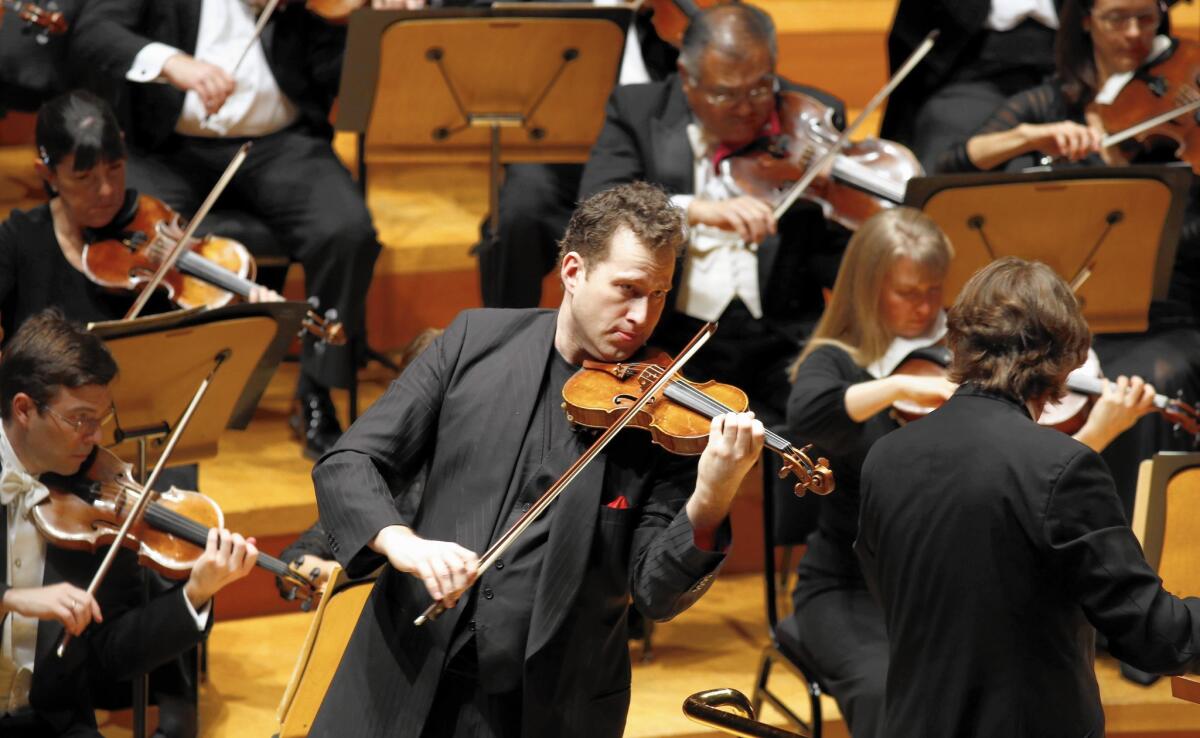Review: Henryk Górecki’s quirky, final major musical statement

- Share via
Henryk Górecki’s Fourth Symphony, co-commissioned by the Los Angeles Philharmonic and given its U.S. premiere Friday night in Walt Disney Concert Hall, is powerful and peculiar. Just like the late Polish composer.
It is a symphony that was not expected to exist, let alone sound the astonishing way it does. But that too happens to be in keeping with Górecki, who came to implausible fame with a 1992 Nonesuch recording of his 1977 Third Symphony. Somehow, the somber CD of what Górecki titled “Symphony of Sorrowful Songs” went platinum, its profound beauty reaching even the pop charts
The one person an unprecedented symphonic success did not suit was the uncompromisingly spiritual — if also unpredictably earthy — composer, who mistrusted material miracles. Apparently, Górecki began his Fourth Symphony in the 1990s. But he was uneasy about a successor to his Third, and he only committed to the L.A. Phil commission in 2007. The score was to be given its first performance by Gustavo Dudamel in 2011, sharing a program with Brahms’ Fourth. The composer, however, died in 2010, leaving, it was believed, the symphony unfinished.
In fact, the piano score for a 40-minute symphony was found among the composer’s papers, and his son, Mikolaj, who also is a composer, has now orchestrated it. Typically when scholars or other composers make performable editions of incomplete concert pieces, they are forced to take stylistic guidance from earlier works. We can never second-guess a genius’ unknowable next step.
But Mikolaj Górecki has done a brilliant job channeling his father. This exceedingly strange and gripping new symphony, which was conducted Friday by Andrey Boreyko (who led the world premiere last year with the London Philharmonic, another co-commissioner), actually sounds like a next, unknowable step. Now we can begin to try to figure out what it all means.
The Górecki Fourth, Opus 85, is a major symphony and possibly a great one. Its title, “Tansman Episodes,” is the first mystery. Alexandre Tansman was the most noted Polish composer between the early 20th century Karol Szymanowski, an important influence on Górecki’s Third, and Górecki himself.
Unlike Szymanowski and Górecki, though, Tansman — who spent most of his career in Paris (although he waited out World War II in Los Angeles) — was not a nationalist composer. He befriended Stravinsky, Milhaud, Gershwin (the car horns in “An American in Paris” were Tansman’s idea) and Schoenberg, and his mercurial style reflected them all. There are no obvious musical connections between the chameleon-like Tansman and the singular Górecki, who begins his last symphony by pounding out relentlessly short melodic motifs based on the letters of Tansman’s name.
The four movements go through weird changes. Strings repeat the motifs over and over, punctuated by a pummeling of syncopated bass drums, the only percussion. When trumpets and horns join in, they are oracular. The piano, placed in the center of the orchestra, adds emphasis. The organ is used for its weight.
Many of the repetitions are exact, but a whack on a drum is sometimes slightly off the beat, or a dissonance is added, or there is a long silence. The symphony begins like a beating healthy heart, but terrifying episodes of arrhythmia come out of nowhere.
There are tenderly lyrical breaks. In the slow second movement, everything stops so that a pair of clarinets can come out of nowhere to play a rising and falling theme in thirds that sounds like Sibelius. Around this point, we begin to sense that pretty much everything in “Tansman Episodes” comes out of nowhere.
The scherzo-like third movement, which sets off with cantankerous horns and trombones stuck in pugnacious grooves, is interrupted by an extended slow, decisively Minimalist section for solo cello and piano (with a solo violin and piccolo) eventually joining in for an episode of hypnotic chamber music. The last movement hints at a folk-like character, but the thumping propulsion is never far away. The symphony closes with a 30-second crescendo by the three bass drums and then a shuddering crash.
Górecki’s Fourth is obviously a statement, but of what? Boreyko conducted with finesse, as if he might tease out meaning. Ben Hong brought a desired richness to his cello solos, Joanne Pearce Martin let the piano accompaniments ring luminously, and Mark Robson set the heavy organ at max and impressively left it there. But I wonder whether Boreyko was a little too manipulative. I could imagine this symphony even slower, louder and more relentless.
The Russian conductor set the scene for “Tansman Episodes” with Tansman’s “Stèle in Memoriam Igor Stravinsky,” written in 1973, two years after Stravinsky’s death. It has elements of late Stravinsky in it, as well as jazzy or chest-beating elements that are not reminiscent of Stravinsky at all. Tansman is a suave orchestrator, which allowed a large L.A. Phil to shine.
Perhaps the few Sibelius seconds in Górecki’s Fourth inspired the inclusion of the Finnish composer’s Violin Concerto on the program. Danish violinist Nikolaj Znaider played with a polish that seemed barely human. He produces a sound thick and luscious as cream. He let each movement flow as though a single uninterrupted thought.
An interruption did occur, however. In a post-concert discussion onstage, Boreyko said he almost stopped and started again when a cellphone invaded the concerto’s hushed opening; Znaider added that he wished the conductor had. But a musician can’t control everything. Maybe that’s the reason why Górecki, a control freak himself, produced a quirky out-of-nowhere symphony as his last major musical statement.
More to Read
The biggest entertainment stories
Get our big stories about Hollywood, film, television, music, arts, culture and more right in your inbox as soon as they publish.
You may occasionally receive promotional content from the Los Angeles Times.











